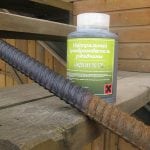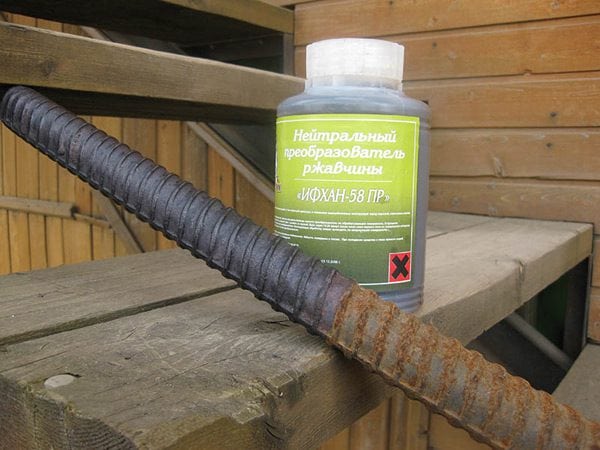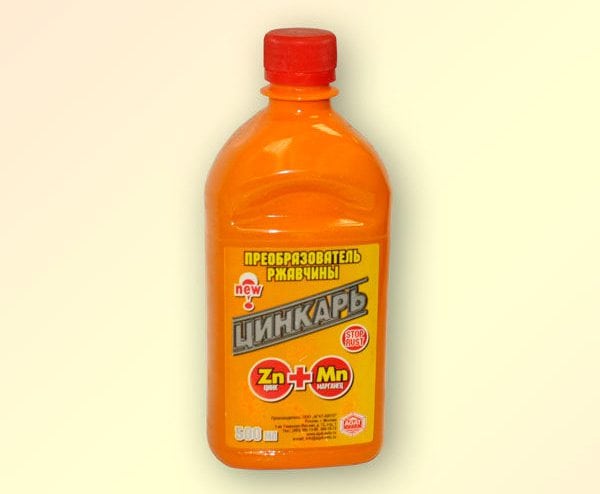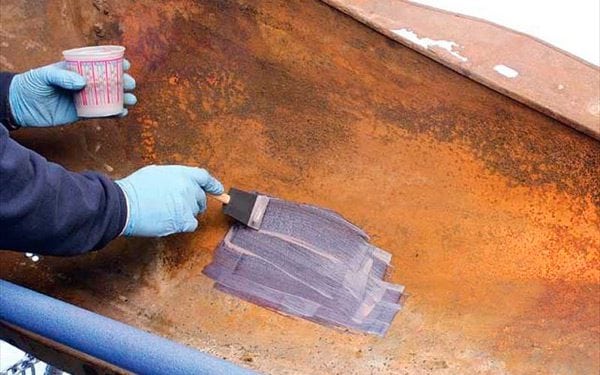Steel is one of the most durable and durable materials, widely used in industry and in private construction. Products made of it can last for decades if they are reliably protected from moisture, which causes oxidation of iron and the appearance of rust. But if it happened that the structure was not processed on time, and corrosion appeared on the structure, in most cases the rust converter will help extend the life of the product.
- Varieties of Modifiers
- Plain
- Complicated
- Primer
- Neutralizing
- PIN
- Second generation PINS
- Features of the choice of modifier
- How to use funds

Now produced a lot of modifiers of corrosion products, differing in composition, protective properties. All of them, entering into a chemical reaction with oxidation products on the metal surface, form a dense protective film that prevents moisture from entering and strengthens the metal base. But such a “treatment” of metal structures is possible only if they are affected by corrosion by no more than 30%. In other cases, the rust converter will be ineffective.
to contents ↑Varieties of Modifiers
Depending on the composition, the transducers act differently. On this basis, they are conditionally divided into groups.
Plain
A converter is called simple due to the fact that it contains only one active component. Its basis - phosphoric acid - entering into a chemical reaction with corrosion elements, blocks the oxidation reaction, creating durable inactive compounds.
Such a composition well slows down the oxidative processes of iron, significantly increases adhesion under the subsequent primer and topcoat.
to contents ↑The disadvantage of this modifier is that the acid residues must be washed off with water after use, otherwise phosphoric acid that does not react with rust itself will cause corrosion of the metal.
Complicated
This rust converter includes, in addition to phosphoric acid, other protective and stabilizing elements, for example, zinc and manganese salts.
The most popular drugs were the Tsinkar series. When applied to the affected area, iron oxides decompose with further phosphate formation. At the same time, manganese and zinc salts enter the reaction, forming a strong protective and stabilizing layer on the metal surface, neutralizing orthophosphoric acid not related to rust. Tsinkar solutions are one of the most inexpensive, effective means to combat corrosion products. After its use, no priming is necessary.
to contents ↑Primer
Rust to soil converter. This composition, in addition to converting aggressive iron oxides into inactive elements, creates a primer layer on the product, suitable for applying paint and varnish coatings on it. Modifiers of corrosion in the soil are available in two bottles: with a solution of phosphoric acid and with a solution of salts. Both of these compounds are combined before use, the finished mixture loses activity after five days.
to contents ↑Neutralizing
A rust neutralizer is an impregnation that includes a paint base and inhibitors that slow down and neutralize corrosive processes.When using such modifiers, inhibitors penetrate corrosion and create a strong film-like compound on the metal surface.
to contents ↑The use of neutralizers is recommended when processing reinforcement before concreting or immersion under water.
PIN
Oil-based film-forming rust neutralizer (PINS) consists of oil-based resins, solvent, additives and various inhibitors. The oil-polymer resin forms a film after processing the corroded area. The use of PINS depends on their additives:
- Some can give the modifier absorption properties. Such mixtures can be used even for processing wet products. They bind water, and then evaporate it during the operation of the processed metal structure.
- Others, penetrating, provide good penetration of the converter deep into corrosion. The result is the most complete chemical reaction.
The disadvantage of PINS is that all the protective films formed by them are soft, do not differ in great strength, but this disadvantage is compensated by the fact that the coating can be easily restored. For this, long restoration work will not be required, it is only enough to renew the damaged area. The use of PINs has found wide application in the processing of components and assemblies of industrial equipment.
to contents ↑Second generation PINS
This rust converter in its composition, unlike the first-generation PINS, has a water-based solvent. As a rule, these are water-wax solutions (IVS). They not only slow down and block the process of rust formation, but also protect the metal base from mechanical damage.
The composition of these PINS is often added, as additives, graphite powder and zinc, which can significantly increase the strength of the protective film formed by the drug. After drying, the soil does not need to be applied; you can immediately apply paint.
The use of all these mixtures, depending on which solution is used, can slow down or completely stop the oxidation processes. This recovery treatment is possible both industrially and with your own hands.
to contents ↑
Features of the choice of modifier
Choosing the necessary tool on the market to combat corrosion and deciding which one to choose, you need to consider:
- What is the location of the object. For example, when processing a rusted water pipe at home, it is not at all necessary to acquire complex compounds; it will be sufficient to use phosphoric acid-based mono-compounds or Zincar-type converters.
- The degree of corrosion. The deeper and wider the area of damage, the more active should be the transforming properties of the modifier. For deep damage it is better to buy mixtures with zinc.
to contents ↑The instructions attached to the drug will help determine which solution is best purchased for a particular case, how to use it correctly and how to dispose of residues after use.
How to use funds
Do-it-yourself restoration of damaged oxidation steel structures is a simple process, but a responsible one. It requires detailed observance of all stages of processing:
- Peel off peeling rust with iron. If this is not done, they will slow down the penetration of modifiers to the base, reduce the quality of the chemical reaction.
- Almost all converters are toxic, work with them must be carried out outdoors or in rooms with good ventilation. It is also necessary to use protective equipment (gloves, respirator, goggles). It is better to wear glasses and a respirator at the first stage of work to prevent the ingress of small metal particles into the eyes or respiratory tract.
- After all work, the residual solution must be disposed of as required by sanitary standards.
- Depending on the surface to be treated, apply the composition with a roller, spray (ready-made spray cans with a modifier or spray gun are used), with a brush, evenly distributing it over the entire rusted area. In some cases, a metal product is doused or soaked.
- After applying the solution, allow the structure to dry.
- If a phosphorus-based mono-composition was used, then after the completion of the chemical process, its excess must be washed off. This operation cannot be neglected - phosphoric acid unrelated to corrosion will cause a new oxidation process.
- If necessary, re-treat the composition. To achieve a stable protective effect, it is better to carry out a 2-fold treatment.
- Depending on which rust modifier was used (a converter to soil or another), the surface, if necessary, is primed with a mixture of metal primers chemically suitable for the applied mortar and the final topcoat, and then it is coated with a decorative protective layer.
With your own hands you can restore from corrosion and extend the life of such metal products as a garage, roofs of houses and household buildings, a car body and many other things that are necessary in the household. The main thing is to choose the best anti-corrosion compound that is best suited to the metal. If everything is done correctly in compliance with the necessary technologies, then after such restorative processing and painting the thing will last a long time.







polyform “red” is very good for car parking